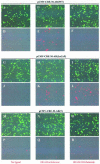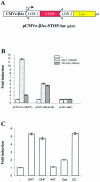Induction of cre recombinase activity using modified androgen receptor ligand binding domains: a sensitive assay for ligand-receptor interactions
- PMID: 12888538
- PMCID: PMC169976
- DOI: 10.1093/nar/gng087
Induction of cre recombinase activity using modified androgen receptor ligand binding domains: a sensitive assay for ligand-receptor interactions
Abstract
Novel systems of inducible gene expression are presented in which CRE-M, an altered form of cre recombinase (cre), is fused to and activated by ligand binding to two forms of the androgen receptor (AR) ligand binding domain (LBD). Selective activation or inactivation of gene transcription is induced upon the addition of appropriate ligand. The coupling of this cre-LBD system with our previously reported highly sensitive assay to measure cre activity in vitro using a dual fluorescent gene switch reporter provides a novel, high-throughput assay system for identifying compounds that bind to and activate various forms of the LBD of androgen receptor. This method can similarly be applied to screen compounds for their activating properties on other steroid hormone LBDs. Three different forms of the AR-LBD were fused to CRE-M, including the wild-type AR-LBD (wt), a non-ligand binding truncated form, LBD (T), and a mutated form (Thr-->Ala substitution) identified in the LNCaP prostate cancer cell line, LBD (LNCaP). We demonstrate a 10-fold induction of cre activity by the addition of androgen agonists to the CRE-M-AR-LBD(wt) fusion protein, but not in the presence of the anti-androgen, flutamide. However, cre activity can be induced by flutamide with the CRE-M-AR-LBD(LNCaP) fusion protein. Similar activation properties were obtained when these fusion proteins were expressed using adenoviral vectors. When combined with our previously reported cre-lox gene switch system, the CRE-M-AR-LBD system can be utilized in gene therapy systems in which a therapeutic product may be initially expressed, replaced by a second product, or turned-off following exposure to ligand. This provides an important, additional level of regulation to gene therapy systems.
Figures





Similar articles
-
Functional in vivo interaction between the amino-terminal, transactivation domain and the ligand binding domain of the androgen receptor.Biochemistry. 1997 Feb 4;36(5):1052-64. doi: 10.1021/bi961775g. Biochemistry. 1997. PMID: 9033395
-
The androgen receptor T877A mutant recruits LXXLL and FXXLF peptides differently than wild-type androgen receptor in a time-resolved fluorescence resonance energy transfer assay.Biochemistry. 2007 Jan 23;46(3):683-95. doi: 10.1021/bi061321b. Biochemistry. 2007. PMID: 17223690
-
Development of two androgen receptor assays using adenoviral transduction of MMTV-luc reporter and/or hAR for endocrine screening.Toxicol Sci. 2002 Mar;66(1):82-90. doi: 10.1093/toxsci/66.1.82. Toxicol Sci. 2002. PMID: 11861975
-
Structural features discriminate androgen receptor N/C terminal and coactivator interactions.Mol Cell Endocrinol. 2012 Jan 30;348(2):403-10. doi: 10.1016/j.mce.2011.03.026. Epub 2011 Jun 1. Mol Cell Endocrinol. 2012. PMID: 21664945 Free PMC article. Review.
-
Peptide antagonist of the androgen receptor.Curr Pharm Des. 2010;16(9):1106-13. doi: 10.2174/138161210790963850. Curr Pharm Des. 2010. PMID: 20030610 Review.
Cited by
-
Hydrogen sulfide represses androgen receptor transactivation by targeting at the second zinc finger module.J Biol Chem. 2014 Jul 25;289(30):20824-35. doi: 10.1074/jbc.M114.559518. J Biol Chem. 2014. PMID: 24942741 Free PMC article.
-
Strategies for site-specific recombination with high efficiency and precise spatiotemporal resolution.J Biol Chem. 2021 Jan-Jun;296:100509. doi: 10.1016/j.jbc.2021.100509. Epub 2021 Mar 4. J Biol Chem. 2021. PMID: 33676891 Free PMC article. Review.
-
Advances in preclinical investigation of prostate cancer gene therapy.Mol Ther. 2007 Jun;15(6):1053-64. doi: 10.1038/sj.mt.6300181. Epub 2007 Apr 24. Mol Ther. 2007. PMID: 17457317 Free PMC article. Review.
-
Neural circuit analysis using a novel intersectional split intein-mediated split-Cre recombinase system.Mol Brain. 2020 Jul 2;13(1):101. doi: 10.1186/s13041-020-00640-2. Mol Brain. 2020. PMID: 32616061 Free PMC article.
-
Inducible model for beta-six-mediated site-specific recombination in mammalian cells.Nucleic Acids Res. 2006 Jan 3;34(1):e1. doi: 10.1093/nar/gnj001. Nucleic Acids Res. 2006. PMID: 16394020 Free PMC article.
References
-
- Le Y. and Sauer,B. (2000) Conditional gene knockout using cre recombinase. Methods Mol. Biol., 136, 477–485. - PubMed
-
- Jaisser F. (2000) Inducible gene expression and gene modification in transgenic mice. J. Am. Soc. Nephrol., 11, suppl. 16, S95–S100. - PubMed
-
- Komatsu K., Suzuki,S., Shimosegawa,T., Miyazaki,J.I. and Toyota,T. (2000) Cre-loxP-mediated bax gene activation reduces growth rate and increases sensitivity to chemotherapeutic agents in human gastric cancer cells. Cancer Gene Ther., 7, 885–892. - PubMed
-
- Reichardt H.M., Kellendonk,C., Tronche,F. and Schutz,G. (1999) The Cre/loxP system–a versatile tool to study glucocorticoid signalling in mice. Biochem. Soc. Trans, 27, 78–83. - PubMed
MeSH terms
Substances
LinkOut - more resources
Full Text Sources
Other Literature Sources
Research Materials

